
Thursday, October 17, 2019
The Central Museum of Mongolian Dinosaurs is only about a kilometer and a half (a mile) from my hotel, and I set out bright and early Thursday morning. This was my first trip to a destination to the north of my hotel, but I had my tourist map of the city, as well as a pretty good idea how to get there. I was getting pretty good at navigating Ulaanbaatar!
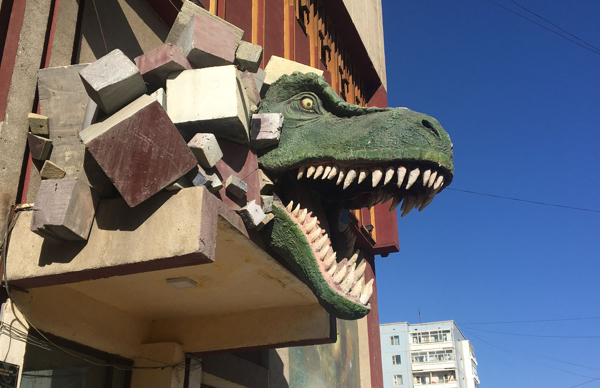 I had no trouble finding the museum, although it was set back a block off the main street and there was nothing marking it, except for a dinosaur head busting out of the side of the building. I headed for the dinosaur head. However, that was a side entrance, for staff. The guard, who spoke no English, pointed me to the main entrance around the corner.
I had no trouble finding the museum, although it was set back a block off the main street and there was nothing marking it, except for a dinosaur head busting out of the side of the building. I headed for the dinosaur head. However, that was a side entrance, for staff. The guard, who spoke no English, pointed me to the main entrance around the corner.
I had read about this museum online and knew that I needed to purchase a ticket for myself, as well as one for my camera (iPhone), if I wanted to take pictures. Of course I did! I paid the ₮5,000 fee x2 (US$1.85 each), and then stopped at the souvenir shop first to look for t-shirts. They not only had them, but in my size! As at the Genghis Khan Statue Complex souvenir shop, these, too, were ₮20,000 each (US$7.50). Finally! I had my Mongolian t-shirts!
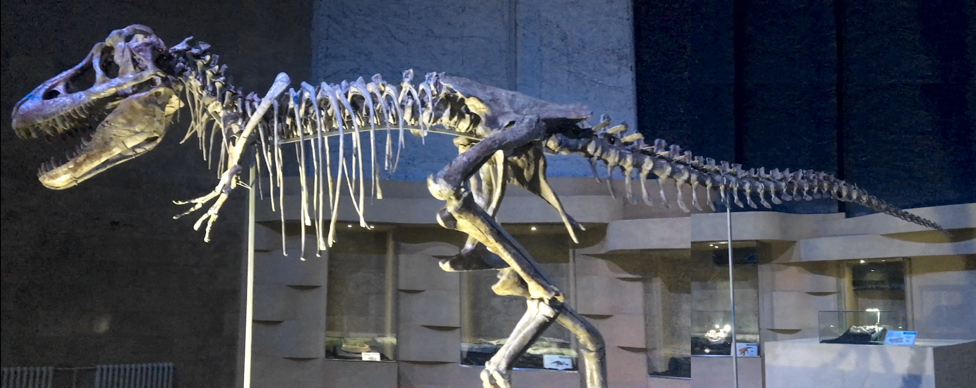
I shoved my new t-shirts in my sling bag as I headed for the museum entrance. A guide greeted me and explained in English how the exhibits were displayed and the museum laid out while I pulled out my phone and eagerly started photographing the exhibits. The museum, she said, was divided into four sections: one downstairs, and three upstairs.
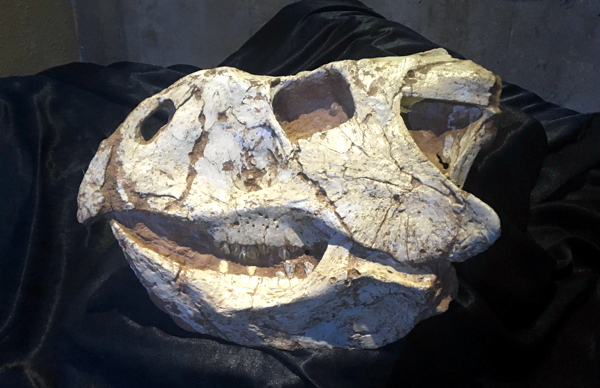 Honestly, I wasn’t paying much attention because up front and center, as soon as I walked in the door, stood the skeleton of a Tarbosauras Bataar. The guide explained it was only a teenager, so it was not yet full grown when it died. I had read about this skeleton. The Tarbosauras was either closely related to the North American Tyrannosaurus, or possibly the same genus; scientists aren’t sure yet. It was a bipedal apex predator, with big, pointy teeth. These puppies grew to about 12 meters long at adulthood.
Honestly, I wasn’t paying much attention because up front and center, as soon as I walked in the door, stood the skeleton of a Tarbosauras Bataar. The guide explained it was only a teenager, so it was not yet full grown when it died. I had read about this skeleton. The Tarbosauras was either closely related to the North American Tyrannosaurus, or possibly the same genus; scientists aren’t sure yet. It was a bipedal apex predator, with big, pointy teeth. These puppies grew to about 12 meters long at adulthood.
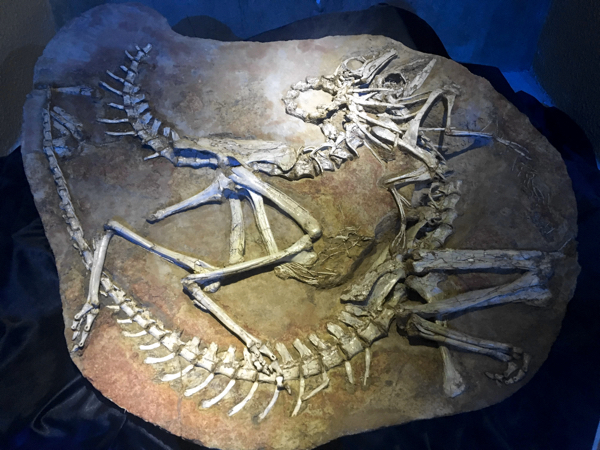 It was a fabulous specimen. I don’t think I’ve ever been that close to a genuine dinosaur skeleton before. I put my iPhone on a selfie stick so I could get in even closer for filming and slowly walked around the display, videoing not only the dinosaur, but also the display placards for later reference. I added some narrative to the video, as well, pointing out interesting things (teeth!) and talking about how the skeleton had been stolen and sold in Texas for a million dollars, prompting the Mongolian government to have to sue to get it back. It was returned in 2013.
It was a fabulous specimen. I don’t think I’ve ever been that close to a genuine dinosaur skeleton before. I put my iPhone on a selfie stick so I could get in even closer for filming and slowly walked around the display, videoing not only the dinosaur, but also the display placards for later reference. I added some narrative to the video, as well, pointing out interesting things (teeth!) and talking about how the skeleton had been stolen and sold in Texas for a million dollars, prompting the Mongolian government to have to sue to get it back. It was returned in 2013.
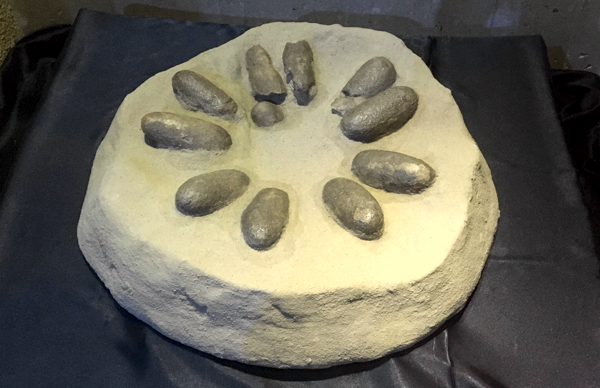 I examined the rest of the exhibits next, also videoing them. I planned to create a video about my trip when I got home, and this would make great footage. I don’t recall ever being able to get as close to fossils as I was at this museum. I was like a kid in a candy shop, not able to get enough!
I examined the rest of the exhibits next, also videoing them. I planned to create a video about my trip when I got home, and this would make great footage. I don’t recall ever being able to get as close to fossils as I was at this museum. I was like a kid in a candy shop, not able to get enough!
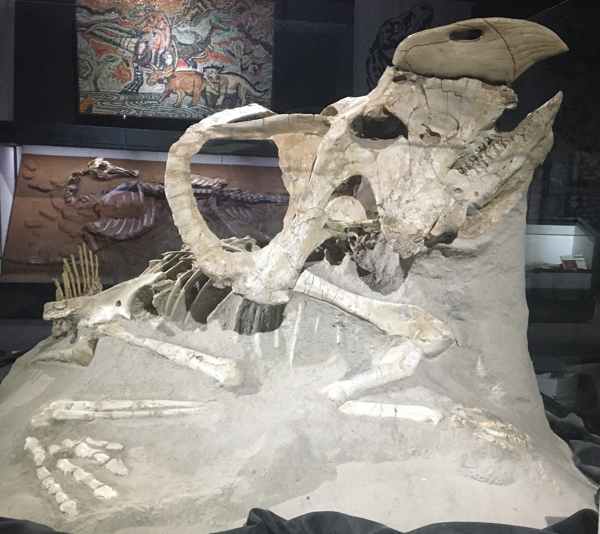 The downstairs exhibits included a nest with dinosaur eggs, the fossilized skull of a Protoceratops, fossilized remains of a Saurolophus Angustirostris and Saurolophus Sp, bones from an Oviraptorosauria and an Ornithomimidae, and more. I found the bones of the Oviraptorosauria particularly interesting because the toe bones had holes. I hadn’t see bones with holes in them like that before. I don’t believe I’ve ever seen dinosaur eggs before either. I don’t know what dinosaur the eggs were from, either, as many of the accompanying placards were in Mongolian, with no English translation.
The downstairs exhibits included a nest with dinosaur eggs, the fossilized skull of a Protoceratops, fossilized remains of a Saurolophus Angustirostris and Saurolophus Sp, bones from an Oviraptorosauria and an Ornithomimidae, and more. I found the bones of the Oviraptorosauria particularly interesting because the toe bones had holes. I hadn’t see bones with holes in them like that before. I don’t believe I’ve ever seen dinosaur eggs before either. I don’t know what dinosaur the eggs were from, either, as many of the accompanying placards were in Mongolian, with no English translation.
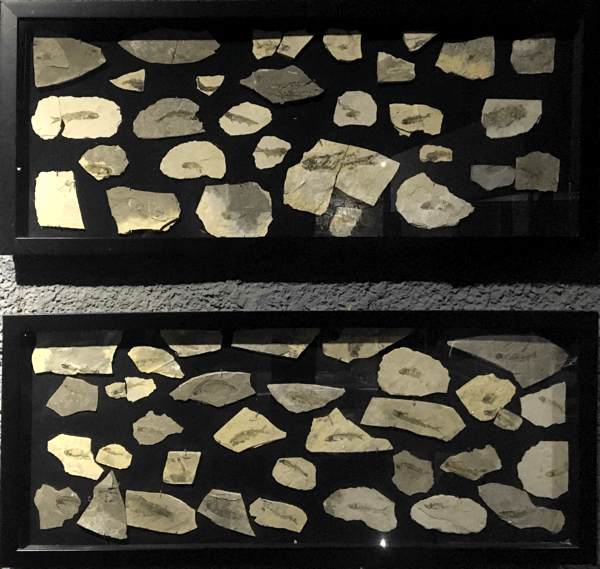 I made my way upstairs and followed the arrows to the left. Just inside the door hung a giant replica of a certificate of transfer of fossils from the US to the Mongolian government. This room contained more bones and fossils in display cabinets, including the skeleton of a protoceratops in the center of the room. The herbivore’s large neck frill made its skull look too big for the rest of it, as did the giant beak-like snout.
I made my way upstairs and followed the arrows to the left. Just inside the door hung a giant replica of a certificate of transfer of fossils from the US to the Mongolian government. This room contained more bones and fossils in display cabinets, including the skeleton of a protoceratops in the center of the room. The herbivore’s large neck frill made its skull look too big for the rest of it, as did the giant beak-like snout.
Several flat cabinets up on the wall contained fossils of fish and other aquatic creatures that had been caught in the mud. The outlines of their little fins and bones showed darkly against the lighter clay, as if reverse x-rays.
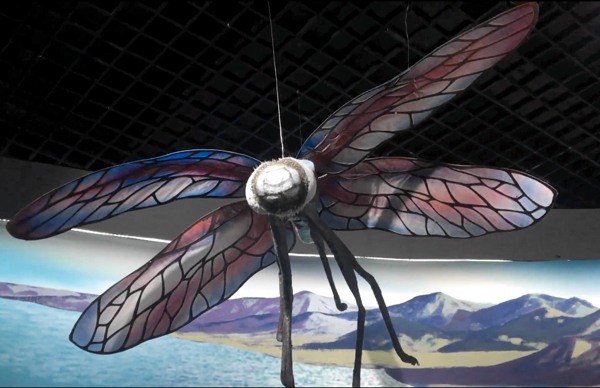 I moved on to the next room, which was a giant diorama. The walls were painted with scenes from the various pre-historic eras, with erupting volcanoes, grasslands, and frozen tundra. The room’s pillars and walls were covered with replicas of fossils. Replicas of creatures that roamed the earth during those periods hung from the ceiling, including giant flying creatures that looked like a cross between a dragonfly and a mosquito. Dinosaurs roamed the grasslands, and a giant blue thing swam slowly through the ocean, looking for food. A sabre tooth tiger hunted on snow-covered plains while a herd of woolly mammoths descended a frozen valley. I slowly scanned the room with my phone, capturing a 360-degree view. Another Tarbosauras Bataar stood in the center of the room. Like the one in the room below, it was stunning.
I moved on to the next room, which was a giant diorama. The walls were painted with scenes from the various pre-historic eras, with erupting volcanoes, grasslands, and frozen tundra. The room’s pillars and walls were covered with replicas of fossils. Replicas of creatures that roamed the earth during those periods hung from the ceiling, including giant flying creatures that looked like a cross between a dragonfly and a mosquito. Dinosaurs roamed the grasslands, and a giant blue thing swam slowly through the ocean, looking for food. A sabre tooth tiger hunted on snow-covered plains while a herd of woolly mammoths descended a frozen valley. I slowly scanned the room with my phone, capturing a 360-degree view. Another Tarbosauras Bataar stood in the center of the room. Like the one in the room below, it was stunning.
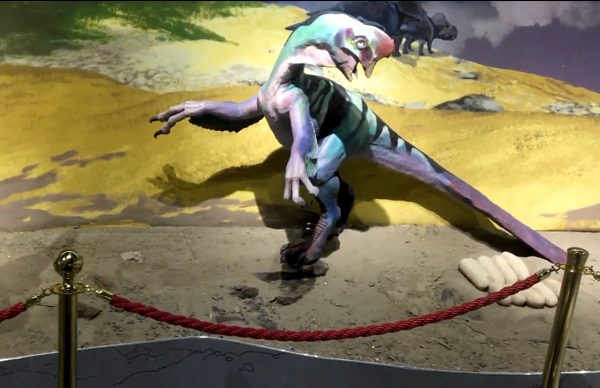 The next room was also a giant diorama with water scenes and display cases containing aquatic and amphibian creatures. Large amphibians resembling salamanders were arranged along the wall, and some interesting toothless creatures hung from the ceiling.
The next room was also a giant diorama with water scenes and display cases containing aquatic and amphibian creatures. Large amphibians resembling salamanders were arranged along the wall, and some interesting toothless creatures hung from the ceiling.
It was quite an experience and one of the highlights of my visit. The museum is well laid out, well lit, and many of the placards and other signs are in both Mongolian and English for those of us who are language challenged. The museum’s shop has a good variety of souvenirs, including t-shirts sized to fit larger people. The staff is very helpful, as well.
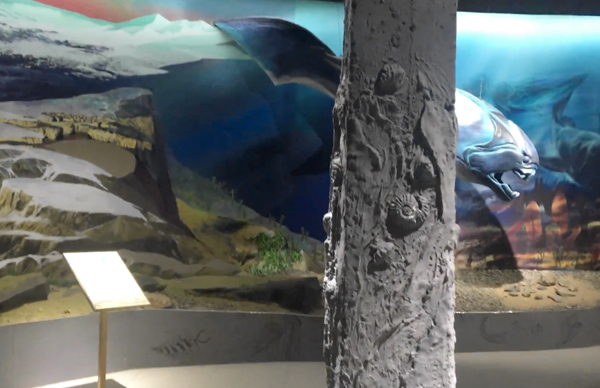 I highly recommend a visit to the Central Museum of Mongolian Dinosaurs!
I highly recommend a visit to the Central Museum of Mongolian Dinosaurs!